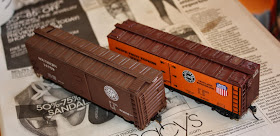In Part 1 of this series on weathering, I showed my paint colors, mixing process, and the basic application of the acrylic pigments to the model, using a fair amount of “wet water” (containing a drop of dish detergent). You can read it at: http://modelingthesp.blogspot/2014/09/my-acrylic-weathering-method.html. My illustrations were about car roofs, and the final appearance, of two models which I was not intending to weather too heavily, is typically like this. The box car roof, in fact, may not even look weathered, but the roof color is now lighter, grayer and duller.
Now we can turn to car sides, once the roofs are thoroughly dry (I would normally wait until a subsequent day). Again, the process is to apply wet water generously, now to sides and ends of the car. You can see below that I am pretty much mopping on the water. And wet the truck sideframes, too. They need to get dirty just like the car side does.
Pigment is now applied, mixed from the gray, umber and black as desired. I usually choose a more blackish mix for cars of eastern railroads, where coal soot was more prevalent, a little browner shade for cars of western railroads. Here I am applying a fair amount of pigment, and you can see the relatively gray color mix I have made for this particular model.
The next step is the same as on roofs, namely to spread the pigment around the sides and ends. Here is a car with a fair amount of pigment, and still pretty wet in this view.
Three things to note in this view: first, the pigment is collecting at the bottom of the sides, just from gravity as the wet material flows downward; second, the trucks have a generous dose of pigment too; and third, a small dry area is already evident at the very top of the sides. Those dry areas need to have the pigment-loaded water stroked upward to cover them. So I am far from done at this point.
The brush can be sloshed in the cup of clean water to reduce pigment load, stroked (on the newspaper you put down under the project) to remove excess water, and then can be used to “wick” water and pigment from the bottom of the car side, and, if desired, stroked upward to maintain a heavier dirt load, or else washed out in the cup to get that much pigment off the car, and reduce the dirt load. Here I am wicking up that water.
With the car side beginning to dry a little, and with pigment loads kept fairly even over the car side. I will pause in the description. There are several more details to understand, which I will cover in the next post.
Tony Thompson





I'm enjoying this series on weathering - looking forward to more!
ReplyDelete